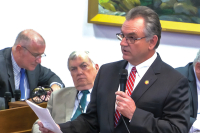Coastal Crusaders
When asked how he felt about the catastrophic BP oil spill, Robert Young paused for the first time during the interview, visibly moved.
“It’s depressing...don’t make me cry,” Young said before walking over to his desktop and opening up a recent home video of his sons enjoying a vacation on the Florida Panhandle.
The water is crystal clear, the sand pure, and his sons are laughing, one riding a boogie board for the very first time.
“I was that boy,” said Young, who heads Western Carolina University’s Program for the Study of Developed Shorelines. “The guys are just dying to go back again...We can’t. We can’t go back now.”
Like many others, Young is finding it difficult to find an outlet for his anger.
“It’s not very satisfying getting angry at a multinational corporation,” said Young. “I can’t not buy gas at the BP station in town. It’s locally owned...We can’t hurt BP. That’s what’s so hard.”
Even with no chance of a do-over on the Gulf Coast crisis, Young and his team of coastal scientists at WCU have gotten actively involved in its aftermath, hoping to make a positive impact.
An unusually vocal scientist, Young’s opposition to the current plan of attack — which calls for building sand berms to block oil from reaching the shores — has earned him national attention.
Young has made the rounds, speaking to NPR, Newsweek and the Rachel Maddow Show and writing an op-ed for The New York Times, actively opposing Louisiana Gov. Bobby Jindal’s push to construct the sand barriers.
Young said there’s little evidence the barriers would work. They would be susceptible to erosion before the project is even complete, not to mention the slim chance that they would survive the impending hurricane season.
Moreover, the sand berms would alter tidal currents, leading to the erosion of natural barrier islands that protect the coast from hurricanes, Young said.
Even with the EPA speaking out against it, the project is moving ahead with the construction of test sand berms. Young is devoted to continue monitoring the process.
Meanwhile, coastal scientists at WCU’s Shoreline program, including two Western grads, Katie McDowell and Adam Griffith, have captured aerial photography during flyovers off the coast of Louisiana.
Last week, Griffith returned to the state to scope out the damage done along the coastline, accompanying two volunteers from the environmental nonprofit Louisiana Bucket Brigade.
What Griffith witnessed upon reaching the beach at Isle Grand Terre left him horrified.
“Oil in large pools was evident on the beach. Hermit crabs wandered around next to bubbles of oil while dolphins frolicked in water that wasn’t quite the right color. Foul fumes were ubiquitous and oil could be seen oozing out of the wetlands,” Griffith wrote in a guest blog entry for LA Bucket Brigade.
That oil will undoubtedly gush to more and more locations. Griffith’s goal, like that of the Bucket Brigade, is to amass a large-scale collection of images to archive the environmental disaster as it unfolds in specific locations.
“Hopefully, these images will help remind us what the land should look like,” Griffith writes in closing his blog entry.
Griffith said the BP oil spill has the potential to be one of the most polarizing moments in our lives, almost like an environmental version of the Sept. 11 attacks.
As a coastal scientist, McDowell said she can clearly grasp how the oil spill will impact the ecosystem for years to come.
“You realize how big-scale it’s really going to be, how devastating it’s really going to be,” said McDowell. “You realize how fragile the ecosystem is.”
Though McDowell hasn’t been back to Louisiana since the flyover in April, she would like to devote every single day to studying the oil spill.
“Everyone wishes they could do more than what they’re doing,” said McDowell. “It’s hard because I think about it all day long.”
Western’s internationally renowned program
Unlike most other programs of its kind, WCU’s Program for the Study of Developed Shoreline houses the oft-separated fields of science and policy under one roof.
That places PSDS scientists in a uniquely difficult position.
“The people who solely do policy and management often think we’re naïve scientists who don’t really have a grasp of the intricacies of politics and policy,” said Young. “The scientific community quite frequently decides not to take scientists who communicate regularly with the public as seriously as scientists who sequester themselves in a lab somewhere, and slip their results under the door.”
But since so many scientific programs receive grants — which are funded by taxpayers — Young said it’s imperative that scientists talk to lay people about their findings.
With few scientific journalists left standing, it’s up to scientists to communicate directly to the public, Young said.
For that reason, the coastal scientists that Young hires must have excellent communication skills. McDowell, for instance, tutored at WCU’s writing center as a student.
McDowell is now working on building a national database that details how high the seas have risen in specific locations during past hurricanes.
In a few weeks, WCU Shoreline scientists will assist in dam removal project in Washington state, one of the largest ever projects of its kind.
PSDS has five full-time staff and, seven research fellows from universities around the country, in addition to one from Ireland.
The program, which has been around for about 25 years, was formerly headquartered at Duke University.
Its director, Orrin Pilkey, handed the program over to Young, who was too enamored with the mountains to move back to Duke, where he completed his graduate studies and is now an adjunct professor.
Pilkey serves as a Young’s mentor and collaborator, and continues to participate in shoreline studies program, officially making it a joint effort between Duke and Western.
PSDS scientists work all over the country, in addition to exotic locales like Morocco, Honduras and New Zealand. Much of what they do involves evaluating coastal engineering projects, whether its building beaches or “mining” sand from the beach to use in construction projects.
The program’s ultimate goal is to preserve and support the proper management of the world’s beaches. PSDS scientists not only work to study the impact of development on shores, but also chime in while harmful policies are being pursued.
For example, Young protested against the idea of building a sea wall to protect a road in Florida’s Gulf Highlands National Seashore.
He said the idea would do more harm than good. Moreover, it wouldn’t work to protect the road. Scientifically speaking, it was simply a bad idea.
Young wrote a two-page scientific opinion and got the signatures of 25 coastal geologists from across the country to sign on before sending it to the head of park services. As a result of their combined input, the effort was abandoned.
Often, PSDS scientists are asked why they’re headquartered in the middle of the Appalachian mountains. McDowell seems well-trained on the response.
“Knowing what we know about global warming, sea level rise, and what happens on the coast, we feel a little bit safer here in the mountains,” said McDowell.
Another tangible benefit is being roughly equidistant from the east coast beaches of North and South Carolina as well as the Gulf. McDowell emphasized that people all over the world study coastal geology, whether or not they’re stationed anywhere near the coast.
Science’s role
Though he opposes the idea of sand berms, Young doesn’t have an answer on what would protect the Gulf Coast from the oil already creeping ashore.
Young is curious why the plan now isn’t to place sand on the barrier islands rather than in front of them. He emphasizes that traditional methods like booming and skimming should not be abandoned.
Young got especially vocal after the governor’s office of Louisiana applied for a permit from the Army Corp of Engineers to do massive engineering. He and his team had examined the proposed project and found major flaws.
“We were concerned about spending all that time and energy and manpower on a project that wasn’t going to work,” said Young. “...No one would be happier for me to be wrong than me.”
If the project had any hope of succeeding, its ancillary environmental effects would not matter. But Young sees a miniscule chance at success.
While other scientists probably agree, few have piped up.
“There are scientists all over the east coast and Gulf Coast, and I haven’t heard them,” said McDowell.
Young, McDowell and Griffith argue that there’s an obligation for scientists to share what they know.
“I think there is tremendous value in science intrinsically, but if we can share that with a larger audience, we can maximize benefit,” said Griffith.
For them, science — not politics — must guide efforts to clean up the oil spill.
A team of the best engineers and scientists should be consulted for every aspect of the response to the oil spill, according to Young.
“We should be putting them in rooms and brainstorming for ideas,” said Young. “We should have them on the scene in places — not so we can conduct yearlong studies —but so we can get as many ideas and eyes on this as possible.”
Griffith agrees that discussion on how to go about the cleanup should be a short part of the project.
“I think science’s perspective is valuable, but I think that part of the conversation needs to occur quickly and concisely,” said Griffith.
Grassroots efforts could also play a significant role, and Griffith said he’s sure there are citizen activists out there already cleaning up oil on their own.
Grassroots Mapping, for example, is using citizen volunteers to send up automatic cameras on kites and balloons to take photographs of the oil-stained shoreline. Those images are then stitched together to form a panoramic aerial shot.
“They’re not talking about what to do,” said Griffith. “They’re doing something.”





